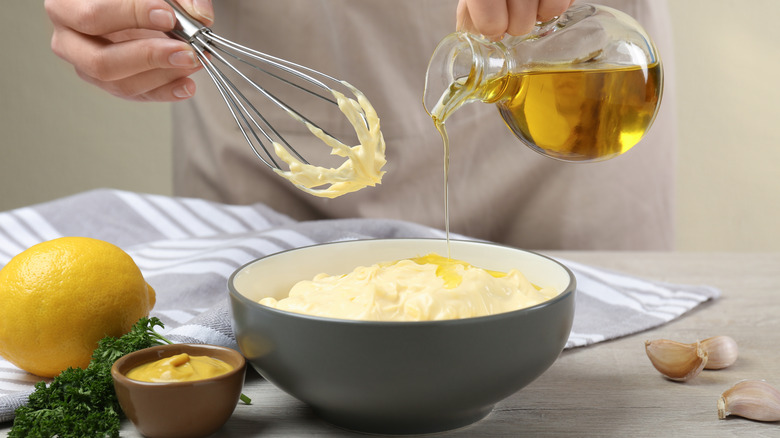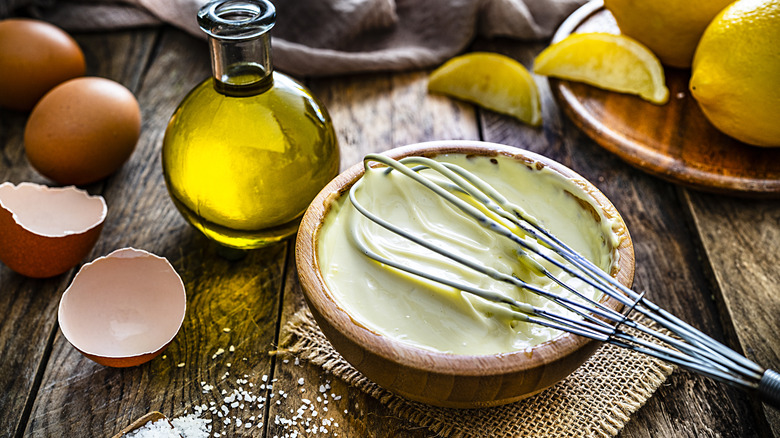Eric Ripert's Oil Tip For Next Level Homemade Mayonnaise
Homemade mayonnaise is a wonderful thing. It has a fresh flavor that you can't always find in a store-bought jar, adding a rich and tangy taste to egg salads, chicken sandwiches, and more. But while it seems simple, there's always a risk of that dreaded moment when the mayo breaks. Mayo is an what's known as an oil-in-water emulsion, as a combination of egg yolks, oil, and an acid such as vinegar or lemon juice. Because oil and water (or vinegar) don't want to mix, it takes some finesse to unite them into a single creamy condiment.
Unfortunately, one wrong turn can result in a separated mixture of curdled fat in a pool of liquid, instead of a sauce that's smooth and silky. If you're feeling intimidated, pro chef Eric Ripert has a tip that can help all the components of your mayo get along better. While whisking the eggs and vinegar together, the French chef recommends drizzling in the oil extremely slowly. This allows the oil to disperse in droplets throughout the mixture in a much more effective way, compared to pouring it in more quickly.
These small oil droplets help to bind the mayo, resulting in a stable emulsion with a smooth consistency. Some patience and elbow grease will vastly reduce your chances of a culinary disaster, which would force you to desperately search for ways to save broken homemade mayonnaise. After all, prevention is always less trouble than finding a cure.
Add oil slowly so it emulsifies with the egg yolk
When you use Eric Ripert's technique, the eggs and oil work together to make a creamy mayo. The lecithin within egg yolks, which is an emulsifier, helps to bind the oil and water molecules, and adding the oil very slowly while whisking allows the lecithin to coat all those little oil droplets. This means the droplets can disperse throughout the condiment without a risk of joining together again, so the mayo is less likely to turn out curdled, split, or overly oily.
There are two ways to incorporate the oil at a slow-enough pace. Firstly, you can gentle pour or drizzle it into the bowl in a steady stream while you whisk. Alternatively, add the oil a teaspoon at the time, if you're worried about accidentally pouring too fast. If you opt for the latter, add one teaspoon and then mix thoroughly, then add another, and so on. You can speed up the process slightly once half of the oil has been incorporated, as the mixture will be more stable by that point.
Ripert's method can be used whether you're whisking by hand, or using a blender or food processor. Using an appliance is faster, but it's only really suitable if you're making a larger batch of mayo. Make sure to only blend the mixture until it just comes together, as over-processing it can increase its chances of splitting.
The best oils to use for homemade mayonnaise
While adding the oil slowly will help to prevent a split disaster, choosing the right oil for your homemade mayo is also important. Fats known as monoglycerides, which are found in many unrefined oils, can increase the likelihood of breaking your mayo. The oil you use obviously also impacts the flavor and texture of the condiment.
Generally, the best options are neutral-tasting vegetable oils, such as safflower, canola, avocado, sunflower, corn, or groundnut, which won't change the mayo's taste. These oils lift up the rich flavors of the egg yolk and lemon, as well as optional additions like mustard. While an expensive first cold-pressed olive oil may be delicious for dips and salad dressings, its stronger flavor adds an overwhelming taste to mayo, making it less versatile. If you really want to use olive oil, try a light version instead.
Eric Ripert favors grapeseed oil for homemade mayo, since it keeps the sauce together even after storing in the fridge, where it will keep for up to a week. He also sometimes uses canola oil for mayonnaise, too. Once you've made a good emulsion with egg yolks and your choice of oil, all that's left is to mix in a teaspoon of acid to help thicken the condiment further and add a bright, tangy taste. Your mayo will be worthy of a Michelin-starred chef like Ripert himself.



